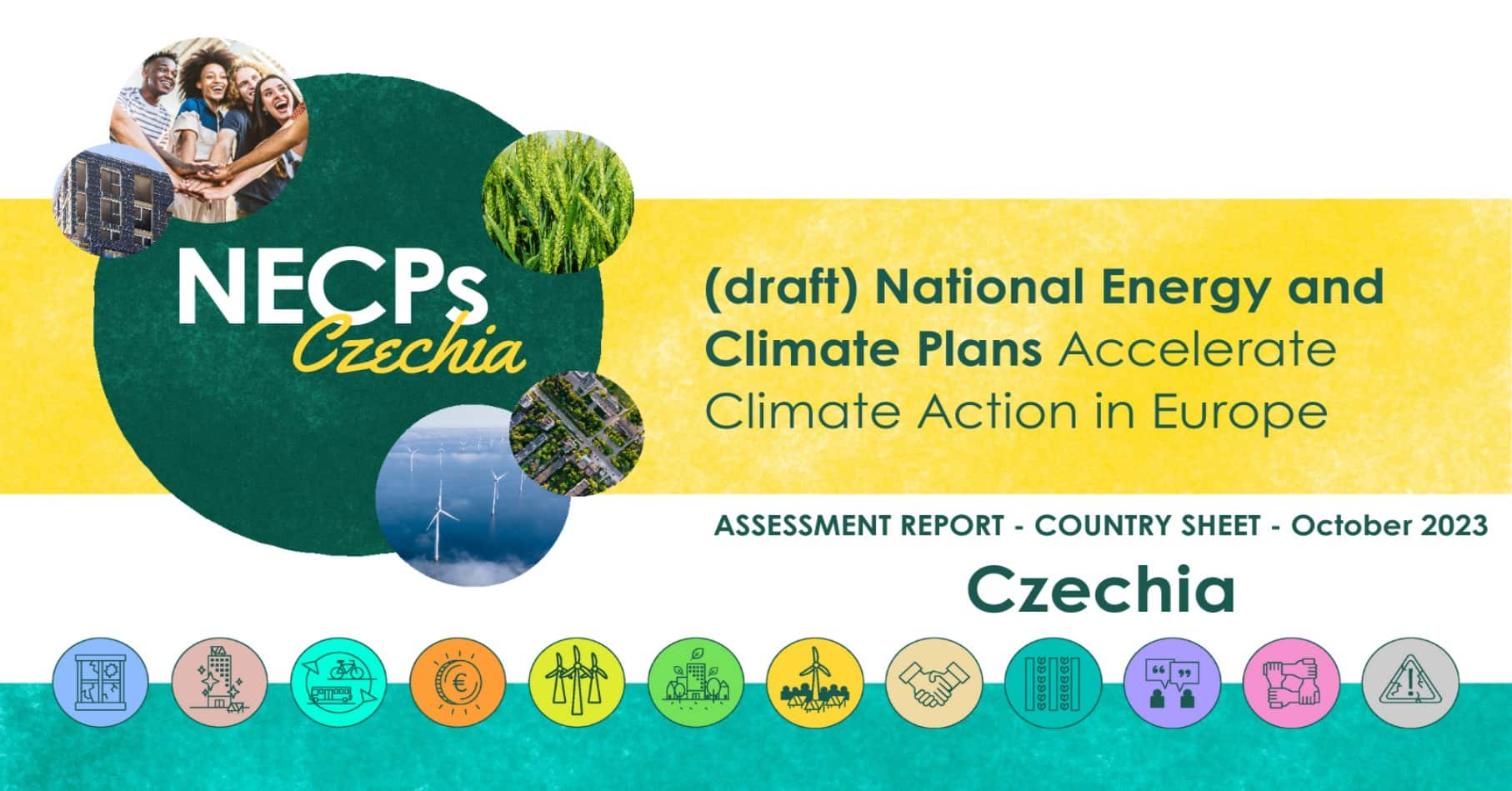Czechia has not yet submitted its draft NECP update, as of 30 September. However, in September it published a preliminary draft, on which this assessment is based. This preliminary draft will probably undergo adjustments before being submitted to the Commission. Czechia overall does not move towards a 1.5°C trajectory. Czechia however fulfils the minimum EU requirements for climate effort sharing. Czechia foresees a level of consumption that is in line with the EU energy efficiency target, but measures are insufficient to achieve the target for final energy. The renewable energy contribution might not be ambitious enough to align with the EU 2030 renewable energy target. Policies and measures (PAMs) presented for climate and are insufficient to achieve the EU 2030 effort sharing target The draft still presents many internal inconsistencies across the document.
RECOMMENDATIONS
- Revise the assumptions for the analytical model. The current one imposes unnecessarily low limits on new solar and wind power deployment, and significantly underestimates costs and timelines for new nuclear sources;
- Identify and properly describe specific measures leading to the proposed targets. Measures in the current draft are too general, lack proper impact assessments and timelines, and they include outdated and often contradictory information;
- Set up a proper public consultation process. The only round of consultations was conducted when no draft, scenarios or any other supporting materials were available.
Climate Ambition
The draft does not define explicit, binding emission reductions targets; rather, it presents them as outcomes of the used scenarios. By 2030, the draft projects an economy-wide emission reductions of -63% (compared to 1990), which improves the 2019 NECP target (-47%); and it also projects non-ETS emissions to decrease by -32% (compared to 2005 levels), which surpasses the minimum requirement set in the unambitious Effort-Sharing Regulation (-26%).
While not in line with a 1.5°C compatible trajectory, these targets would allow Czechia to be consistent with the increased EU ambition levels. However, their credibility is uncertain. The section on PAMs is outdated and incomplete, completely misaligned with the scenario with additional measures. It only includes some of the already existing PAMS, and it describes them poorly – without clarity on the analytical basis, the scope, and their impacts on emission reductions. Also, it often refers to outdated documents, instead of the updated targets.
Energy Transition
In the preliminary draft, Czechia sets a renewable energy contribution of 30% in 2030, which might not be in line with the Governance Regulation formula benchmark to reach the binding EU 2030 renewable energy share of 42.5%. For what concerns PAMs, Czechia has included some positive elements on the simplification of administrative procedures and on acceleration zones, but they lack detail, notably about their expected impact. The draft also mentions support to energy communities and energy sharing, but Czechia still needs to fully transpose RED II.
For energy savings, the level of consumption in 2030 is estimated at 1206 PJ of primary energy and of 846 PJ of final energy, which equals 28.8 Mtoe and 20.2 Mtoe respectively. This is in line with the EU 2030 energy efficiency target, compared to the formula benchmark of the 2023 Energy Efficiency Directive (EED). However, projections of energy efficiency policies and measures only reach a level of 945 PJ (22.57 Mtoe) by 2030 for final energy, therefore additional policies and measures are needed. Except for generalities on building renovation measures, most measures have not been updated compared to the 2019 NECP.
FOSSIL FUELS ALERT
- Coal – Coal phase out is foreseen by 2033. However (1) this is not reflected in the PAMs, where coal phaseout is not addressed; (2) the possibility of an earlier phaseout is not sufficiently considered; (3) there is a risk that lignite mining (Bilina mine) is prolonged until 2035, in direct contradiction with the government’s objectives. A coal mining end date should be added in the draft.
- Fossil gas – No fossil gas phaseout is foreseen. Fossil gas capacity is expected to increase by 2030 and fossil gas infrastructure to expand, in contradiction with the overarching decarbonisation goals.
FALSE SOLUTION ALERT
- Nuclear – Beyond 2030, the scenario with additional measures relies too much on a large-scale deployment of new nuclear sources. The timelines provided for their construction are unrealistic, and so are the expected costs (CAPEX 5400 euros per thousand watts of electric capacity /kWe, WACC 4 %), compared to any other ongoing construction in comparable conditions.
- CCS – The 2050 net zero target overly relies on CCS for biomass, instead of promoting forests restoration (forests still emit more CO2 than they absorb at the moment).
IS MONEY WHERE THE MOUTH IS?
- The plan lacks an overall comprehensive analysis of PAMs investment needs. As a consequence, the integration of all funding in the plan – including EU funds, EU ETS revenues and SCF revenues – is quite poor, which decreases their effectiveness.
SNEAKY SUBSIDIES
- On subsidies, the draft is almost identical to the 2019 NECP. Czechia does not have data available on its fossil fuel subsidies apart from its OECD reports; it only considers direct subsidies, omitting indirect and implicit ones; and it does not plan dates for their phaseout.
PUBLIC PARTICIPATION
- Public consultations were poor. The only round of consultations was conducted via an online questionnaire, with a few broad questions and for only 3 weeks. No draft, scenarios or any other supporting materials were made available. No information was provided on the extent to which comments were reflected in the draft.
- A Platform for Energy and Climate Strategies was established in April. However, it fails to meet the function of a multilevel dialogue: regions and cities are only represented through associations of cities and regions, without any consultations happening at the local or regional level. Members of the platform also often had very little time for comments on proposed drafts.
Download czechia country sheet NECP assessment report
Download FULL NECP assessment report
PREVIOUS
NEXT

